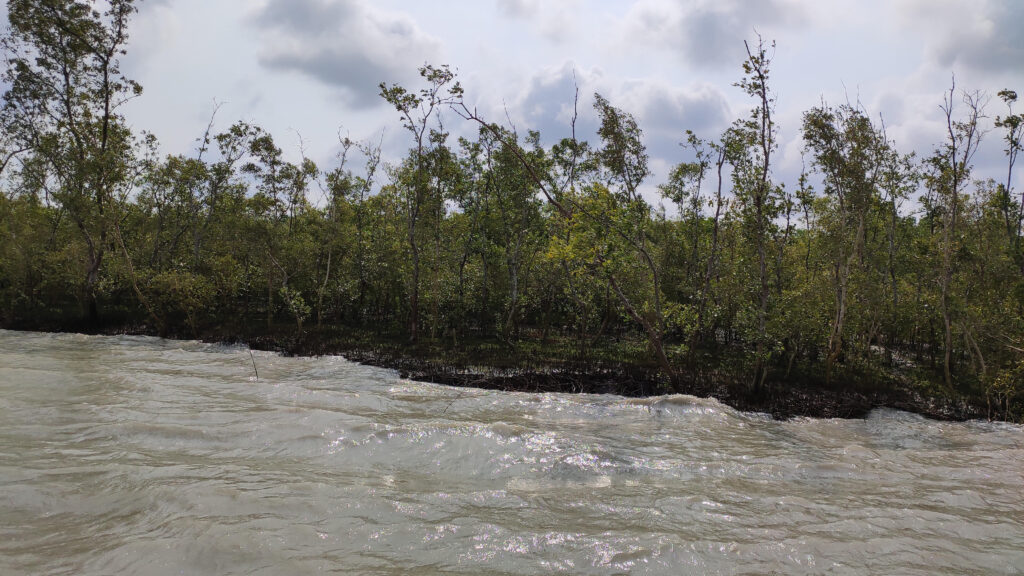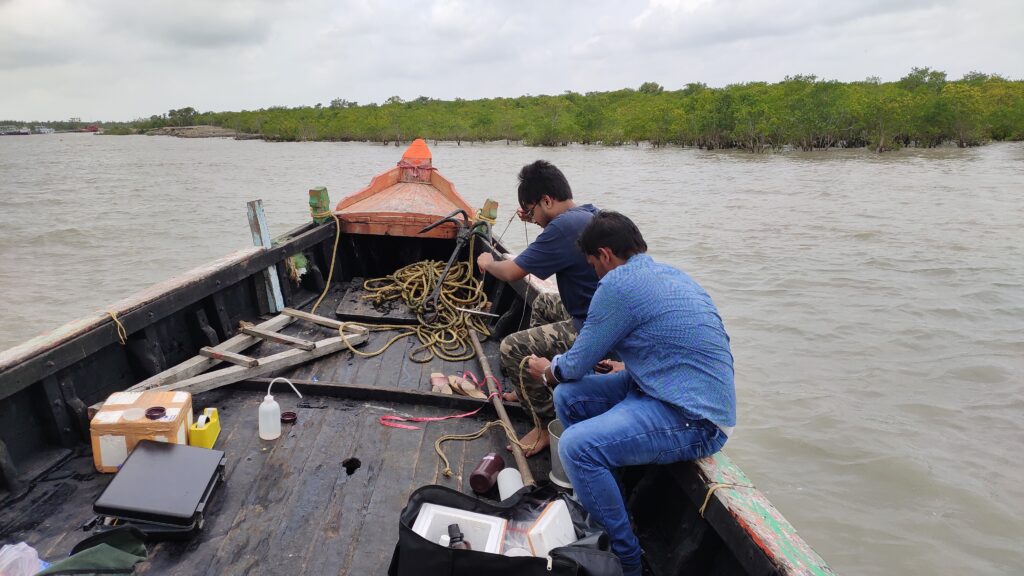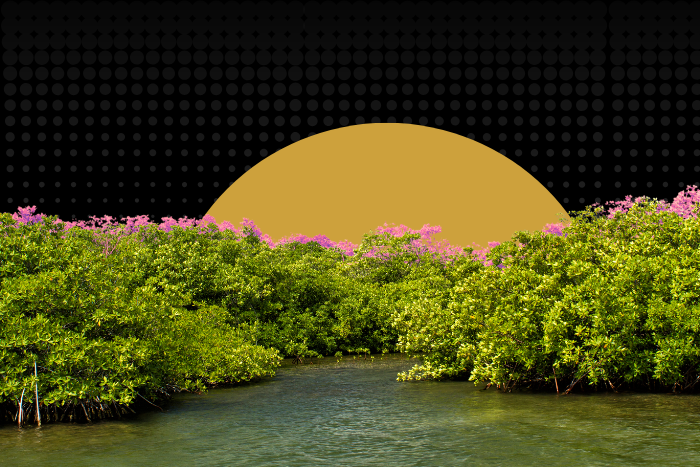Amidst uncontrolled urbanisation and funding challenges, nurturing existing mangroves through site-specific restoration strategies has yielded better results than mass planting for some conservation experts
On October 25, Cyclone Dana slammed into the eastern coast of India at wind speeds of 120 km/hr, causing extensive damage in Odisha and West Bengal. It affected over 4 million people and is estimated to have caused Rs. 600 crore worth of damages in Odisha alone.
On the other side of the world, in the US, Hurricane Milton flattened Florida a month ago. With winds of 195 km/hr, spawning 41 tornadoes and taking 24 lives, the storm is expected to have caused up to $34 billion in damages. And just two weeks prior to that, Hurricane Helene, the fourth-deadliest hurricane to hit the USA since 1950, claimed over 200 lives and caused upward of $30 million in damages.
As oceans get warmer due to climate change, such storms are becoming more frequent and intense. In east and southeast Asia, cyclones Gaemi and Yagi claimed close to 1,000 lives this year, while cyclone Remal flattened parts of India and Bangladesh.
In 2023, floods and tropical storms constituted 85% of the world’s costliest natural disasters due to climate change, found a report by the UK-based non-profit Christian Aid.
While coastal communities brace for these escalating threats, protecting coastlines has become imperative, and mangroves stand as the first line of defense. But in a rapidly expanding economy like India’s, these natural guardians are left vulnerable, facing destruction at an alarming rate. Given their crucial role in shielding coastal areas from climate change impacts like cyclones and erosion, what are the most effective strategies for mangrove conservation and restoration? And are they more effective than mass mangrove plantation efforts?
A natural solution to coastal protection
In India, the state of West Bengal has suffered the impacts of some of the most devastating cyclones rising from the Bay of Bengal in the past two decades, including Aila, Fani, Amphan and Yaas.
A report by the Environment Ministry of West Bengal found that areas with thick mangrove cover suffered significantly less damage from cyclones than areas with scanty mangrove cover.
In fact, the damage from cyclone Dana was considerably minimised in certain areas in Odisha, like the Bhitarkanika National Park, due to the presence of mangroves.
India plans to reforest 540 sq km of India’s coastline within five years, under the Mangrove Initiative for Shoreline Habitats & Tangible Incomes (MISHTI) scheme, as part of the Mangrove Alliance for Climate (MAC). The alliance was launched on the sidelines of the Conference of Parties (CoP27) at Sharm El-Sheikh in Egypt, in 2022. Headed by UAE and Indonesia, the alliance pledged $4 billion to conserve 15 million hectares of mangroves worldwide. Its objective is spreading awareness about mangroves’ crucial role in combating global warming, while conserving and restoring mangroves.
Mariam bint Mohammed Almheiri, UAE’s Minister of Climate Change and the Environment, even proposed planting 100 million mangroves by 2030. In 2022-2023, the UAE claims that it has planted 23 million mangroves.
Planting mass mangroves might sound promising on paper, but is it a knee-jerk reaction to extremities caused by climate change? Conservation experts say continuously planting new mangroves, as is one of MAC’s suggestions, doesn’t seem to be the most effective.

The challenges of mass plantation
Newly planted mangroves struggle to survive in erosion-prone areas, or where tidal action is high. The report by West Bengal’s environment ministry found that mangroves find it hard to grow in the open, eroding sections of the coast.
After Cyclone Amphan hit the region in 2020, West Bengal announced an ambitious project to plant 5 crore new saplings spread over 2,500 hectares. But only 30,000, or 15% of the planted saplings survived in a 10-hectare area where 2,00,000 seeds were planted.
The failure of such random plantation is in line with experiences elsewhere, too. The survival rate of mass plantation of mangroves in Kenya, for example, was only 30-32%, according to a report by Nation. Sri Lanka’s efforts after the 2004 tsunami saw just 3% of planted saplings survive.
Following the failure, Sri Lanka decided to make a shift to scientific conservation in 2015, focusing on nurturing existing mangroves and letting them expand naturally instead of planting new ones. This has resulted in over 500 hectares of restored mangrove cover till date. This programme was selected as one the seven UN World Restoration Flagships as well.
The curse of unchecked urbanisation
Back home, India’s financial capital Mumbai, however, seems to be losing the fight to protect its mangroves. “Close to 15-20% of mangroves in the city have been destroyed, while the destruction is 30-40% in the larger Mumbai Metropolitan Region. However, restoration has been only done in 2% of the entire region,” says Stalin D, director of the non-profit Vanashakti.
Areas outside the city are in worse danger, especially from unchecked development carried out by CIDCO and Jawaharlal Nehru Port Authority, says Stalin. Which is why, to protect the remaining mangrove cover in MMR from being exploited, the Forest Department of Maharashtra has rolled out an elaborate and expensive surveillance plan. More than 650 CCTV cameras will be installed from Dahisar to Panje wetland and Colaba to Panvel.
Mangrove losses are troubling as the incidences of cyclones in the Arabian Sea have been increasing due to climate change. Its temperature has risen by 1.2°C to 1.4°C in the past four decades, leading to a 52% increase in cyclonic storms in the past two decades. This is worrisome for India as the nearly 3,000-km long western coastline, running from Gujarat to Kerala, hosts a higher population as well as industrial centres and critical trading ports. Around 250 million people depend on the coast for their livelihoods like fishing, agriculture, tourism.
In Mumbai alone, nearly 22 million people face an existential threat from the sea. “What will happen when coastal erosion gets accelerated? Walls can’t stop coastal erosion, only mangroves can stop them,” says Stalin.
He chastises the government initiatives to build sea walls at various Mumbai beaches, which will be eventually redundant in the face of rising seas. “When you create a crisis for the city, then institutions like the World Bank will come running to lend money,” he says.
On the other hand, conservation efforts by organisations like Vanashakti are suffering due to a lack of funding. With no money coming from the government and big corporations, and foreign funding being blocked due to national policies, they are walking a tightrope, he said.
Unfortunately, just like in Mumbai, mangrove losses have been sizable across the globe. Between 2000 and 2020, around 6,769 sqkm — an area larger than the Asian nation of Brunei — has been lost, according to a report by the Global Mangrove Alliance.
While half of that area has been reforested, it is a challenging task. So how should conservationists go about it?

Pristine defences
Some answers can be found 2,000 km away from Mumbai—on the eastern coast of India — in the Sundarbans, the world’s largest mangrove forest, and among UNESCO’s world heritage sites.
The riverbank at Ramganga village seemed like a pristine rural painting – a lush mangrove belt, stretching for three hectares around the concrete embankment. Thirty different species of mangroves stand tall—a necessary defence against the great eroding forces of four rivers converging at the village in the Pathar Pratima block.
It is hard to imagine that this patch of land was barren just a few years ago.
This is one among 31 sites that Krishna Ray, a botany professor at the West Bengal State University, has been developing since 2013. Dr. Ray takes a scientific and logical approach to mangrove plantation and restoration. Instead of mass planting mangroves, she focuses on creating the right environment for them to first survive, and then thrive.
Firstly, mangroves can populate in abundance in their natural habitat without much intervention. An experiment carried out in the western coast of Malaysia found that mangrove ecosystems can be regenerated without new plantations, by simply erecting a breakwater and facilitating a conducive environment for mangrove growth.
Secondly, new plantations have varying success rates because all saplings do not grow into full-fledged trees, depending on tidal action and erosion in those areas.
Thirdly, if a single or a few widely available types of mangroves are planted, then the result will not be as effective, as this will fail to create a diverse ecosystem.
“Some mangrove species grow in soil with high salinity content, while others prefer sweeter areas. So, for greater efficiency, areas have to be mapped according to salinity, and then the suitable species have to be planted,” says Dr. Ray, who has successfully been able to grow dense mangrove belts in absolutely barren areas and mudflats.
At the 5-year-old site in Durbachoti, this method is visible. Manually planted rows of grass stretch out towards the river, while a dense mangrove forest is taking hold of the embankment.
A case for scientific intervention
“We first plant grass on a completely barren mud flat. These enrich the soil by increasing nutrients, making it more conducive for planting trees. Then, we transplant locally available mangrove species, while introducing some globally threatened ones. This increases biodiversity, regenerating the cycle,” says Dr. Ray.
The grass is a critical anchoring component, especially when growing mangroves on mudflats, where they are not found traditionally. According to the International Union of Conservation of Nature, mudflats are “too exposed to erosion and wave action”, and the “low oxygen content due to constant moisture can result in high seedling mortality and stunted growth”.
More importantly, solutions have to be hyper local — tweaked according to geographical conditions of the place, even if it’s part of the larger ecosystem.

“A rule of thumb for conservationists should be collecting information from local communities about which mangrove species existed there historically,” says Narendran Rajendran, a mangrove restoration expert based out of Tamil Nadu.
His scientific restoration work at four sites in Parangipettai, in the Cuddalore district of Tamil Nadu, resulted in 90% of newly planted mangroves surviving. Planted around seven years ago, the sites have turned into such dense forests that he is not able to enter the sites anymore, and the mangroves keep expanding on their own.
“Species should be planted depending on hydrography and nutrient content of the soil. We dig the top 15-30 cm of the soil, study the nutrient gradation, and observe the abundance of crab holes – more means greater biodiversity,” he says.
This can be evidenced in Sri Lanka’s successful mangrove plantation drive. Its guidelines document states what elements should be studied for effective mangrove restoration. “Mangrove species distribute along gradients of salinity, pH, soil moisture level and depth of aerobic soil layer. Hence, for effective restoration these parameters should be measured in advance,” it states. Parallely, salinity levels, tidal fluctuation, wind and intensity of sunlight also impact mangrove growth, and hence, restoration effort, states the document.
Dr. Ray’s team has also been following similar principles at another site in Durbachoti, Sundarbans. “Sediment gets deposited on the low-lying grass by the river during high tide. When the water recedes, it gets trapped in the undergrowth. The sediment dries off and falls onto the soil, increasing its organic matter and thereby nutrients,” says Dr. Ray.
The more the plantation moves towards becoming a pristine forest, new plants, leaves and grass grow in the place of old ones. The withered grass and fallen leaves themselves become manure for the soil, ever increasing its nutrients.
And then nature does the rest. Seedlings are brought in by the river, which get locked in the dense vegetation, thereby giving birth to newer and diverse types of trees. This attracts organisms such as crabs, shrimps, algae and phytoplankton, which enrich the ecosystem. Crabs, especially, are very important as they burrow deep into the soil, aerating it, thereby increasing its nutriency.
And once the pristine conditions are established, various types of seedlings of all these different trees will be carried by the rivers to nearby places, gradually increasing their biodiversity as well. In this manner, the cycle will keep running and all areas would benefit.
Once this is done, it’s simply a matter of maintaining the sites and not let it be destroyed by human activities. That’s where the seven-member team is crucial.

Old is gold
The common notion at policy level is that mangroves are crucial for decreasing the effects of global warming and reducing the level of carbon in the atmosphere, as they are great carbon sinks. Another direct benefit is protection of coastal regions against rising seas and extreme weather events such as cyclones.
But having a pristine mangrove forest has far greater advantages. A US-based study, which analysed four decades of data, found that planted mangroves stored up to 75% of the carbon stocks found in intact, mature ecosystems.
The livelihood of the riverfolk and coastal communities also depend on it. From catching fish and collecting honey to having an ample supply of wood, the indirect benefits are multifold, which can provide much-needed income sources to these marginalised people.
But a monotypic conservation of mangroves will not guarantee these benefits. At a site not handled by Dr Ray’s team, there were only three types of mangroves that put up a basic defence against surging waters, but there was no undergrowth. This did not allow the sediment to be retained or other plants to grow, and thus no biodiversity.
Another important unaddressed problem is that mangroves cannot be planted everywhere. The success rate of the seedlings growing into trees vary according to the area. Even in one forest like the Sundarbans, the conditions can be massively different.
Roughly 30 km to the west of Ramganga, at Sagar Island, planting new trees is simply futile. The reason is simple. “Since the waves are very strong, new mangroves won’t survive,” says Dr. Punyasloke Bhadury, a professor at the Department of Biological Sciences, IISER, Kolkata.
Instead of planting new trees, he focuses on saving 25-30 year-old mangrove trees that somehow managed to survive the ravages of the devastating Cyclone Amphan. His methods have been successful in the area of Chemaguri, one of the inlets in Sagar Island.

“The resilience of these mangroves are more. So we are trying to restore them. We chose this site because the level of erosion and sea level rise is highest here. Cyclone Amphan had severely damaged this portion, but the intervention by our team has improved the conditions. Now, Chemaguri boasts of the densest patch of mangroves in Sagar Island, roughly 2-3 sq km,” says Dr. Bhadury, adding that the area is very important for the locals as they come here to catch crabs.
His methodology is also simple. Since 2010, he has been studying how the ecosystem is changing over a period of time — “a systematic snapshot” and the “only time series of mangroves in South Asia”. His team is studying the change through different parameters for water, land and mangroves, and analysing what it requires.
At his lab, he creates ideal conditions for improving the ecosystem, accelerates the process artificially, and then introduces the subjects here, thereby boosting the ecosystem, making it go back to its pristine conditions that it was 25-30 years earlier.
“Whatever percentage of new plantations survive, they will take at least 15-20 years to grow full-fledged where they will be able to withstand the extreme forces of nature. So, isn’t it better to save and repair existing ones who already have that strength? It will take only a couple of years,” says Dr. Bhadury.
It seems as though the key to success lies in localised solutions that target long-term sustainability. While mass mangrove plantation efforts are well-intentioned, they often meet the fate of inland mass plantation drives which have low survival rates. As the conservation experts in this article have shown, nurturing existing mangroves through site-specific restoration strategies has yielded robust results. In the face of uncontrolled urbanisation and funding challenges, empowering nature to regenerate itself may be the best hope for saving the world’s remaining mangroves—and the coasts they protect.
About The Author
You may also like
Fog grips North India as cold wave spreads across central and southern states
Rains Lash South India as Early Cold Wave Grips Central and Northern India
India launches National Red List Assessment to map extinction risks of 11,000 species
Can Private Players Reinvent India’s Forecasting Future?
At least 10 dead in heavy rain in Maharashtra, Mumbai crosses 3000 mm threshold

